Risk Assessment of Artifact Degradation in a Museum, Based on Indoor Climate Monitoring—Case Study of “Poni-Cernătescu” Museum from Iași City
Abstract
:Featured Application
Abstract
1. Introduction
2. Materials and Methods
- four sensors mounted in the exhibition circuit halls at 1.5 m above the floor, near the walls, as follows: one in the north-east room—library (S1), one in the south-east room—living room (S2), one in the north-west room—Radu Cernătescu room (S4), and the last one in the basement (S3);
- two sensors were mounted on the external walls of the museum, one to the northern (S6) wall and the other on the southern (S5) wall, at 2 m above ground level.
3. Results and Discussions
3.1. Outdoor Hygrothermal Characteristics in the Museum Microclimate
3.2. Annual Variations in the Indoor Air Temperature and Relative Humidity
3.3. Specific Climate Risk Assessment Results
4. Conclusions and Recommendations
Author Contributions
Funding
Acknowledgments
Conflicts of Interest
Appendix A
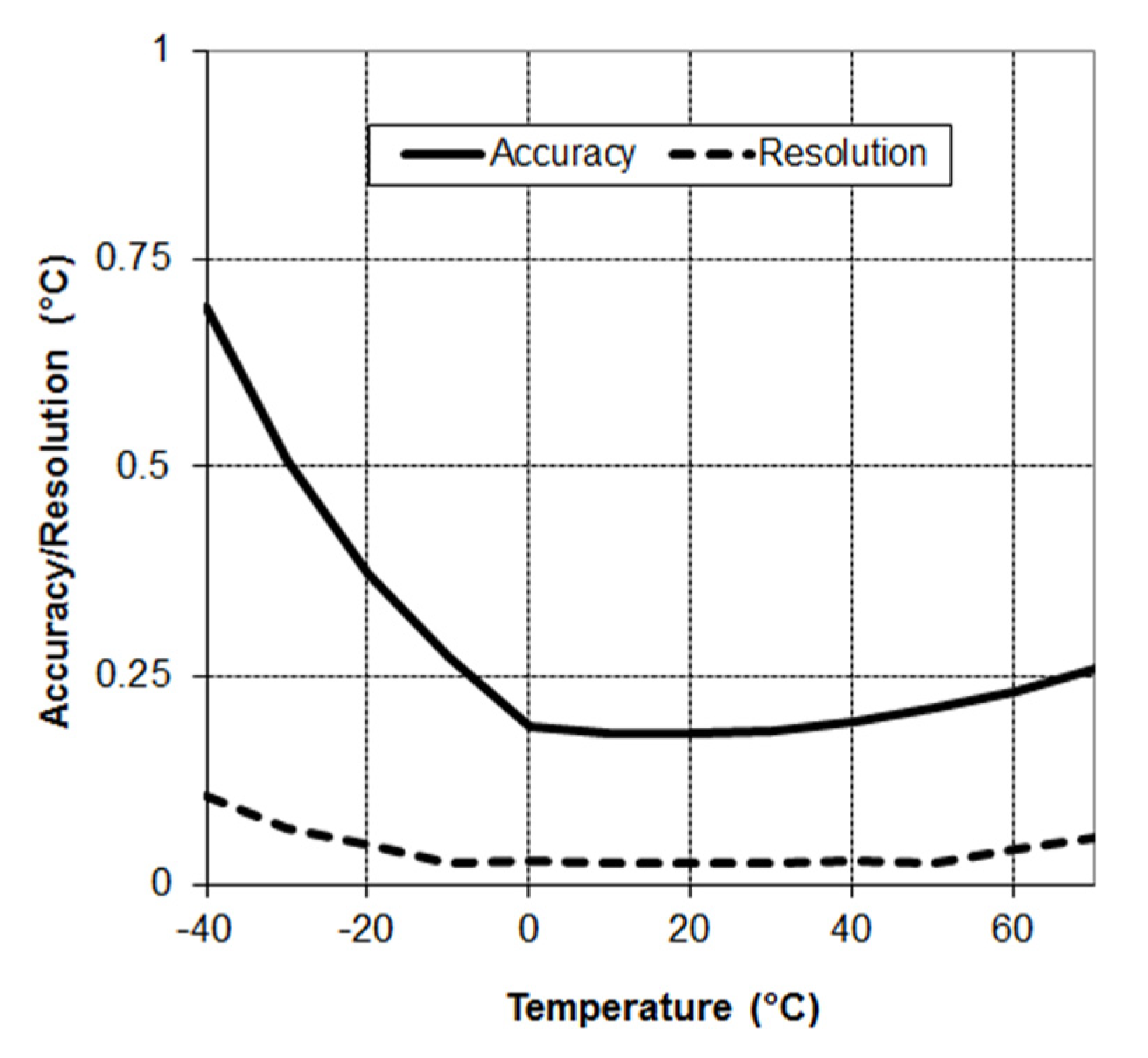
| Mechanism | Scientific Basis | Application | Preservation Measure | Algorithm | Interpretation |
|---|---|---|---|---|---|
| Chemical deterioration | Chemical reaction kinetics | Organic materials (paper, fabrics, wood, etc.) | Preservation index (PI) | Calculated from temperature and humidity data | Comparative analysis: when it is higher, it is better |
| Physical and mechanical deteriorations | Typical wood physical behavior | Hygroscopic materials (wood, paper, fabrics, etc.) | Moisture content in equilibrium conditions (EMC) | Estimating EMC variations over time | Risk in extreme conditions: max EMC > 12.5%, min EMC < 5%—risk min EMC > 5%, max EMC < 12.5%—good |
References
- Spiridon, P.; Sandu, I. Museums in the Life of the Public. Int. J. Conserv. Sci. 2016, 7, 87–92. [Google Scholar]
- Sandu, I.C.A.; Spiridon, P.; Sandu, I. Current Studies and Approaches in the Field of Cultural Heritage Conservation Science. Harmonising the Terminology in an Interdisciplinary Context. Int. J. Conserv. Sci. 2016, 7, 591–606. [Google Scholar]
- Spiridon, P.; Sandu, I.; Stratulat, L. The Conscious Deterioration and Degradation of the Cultural Heritage. Int. J. Conserv. Sci. 2017, 8, 81–88. [Google Scholar]
- Lucchi, E. Review of preventive conservation in museum buildings. J. Cult. Herit. 2018, 29, 180–193. [Google Scholar]
- Florescu, O.; Sandu, I.C.A.; Spiridon-Ursu, P.; Sandu, I. Integrative Participatory Conservation of Museum Artefacts. Theoretical and Practical Aspects. Int. J. Conserv. Sci. 2020, 11, 109–116. [Google Scholar]
- Pavlogeorgatos, G. Environmental parameters in museums. Build. Environ. 2003, 12, 1062–1457. [Google Scholar]
- Romano, F.; Colombo, L.P.M.; Gaudenzi, M.; Joppolo, C.M.; Romano, L.P. Passive control of microclimate in museum display cases: A lumped parameter model and experimental tests. J. Cult. Herit. 2015, 16, 413–418. [Google Scholar]
- Camufo, D.; Bernardi, A.; Sturaro, G.; Valentino, A. The microclimate inside the Pollaiolo and Botticelli rooms in the Uffizi Gallery, Florence. J. Cult. Herit. 2002, 3, 155–161. [Google Scholar]
- Fabbri, K. Historic climate in heritage building and standard 15757: Proposal for a common nomenclature. Climate 2022, 10, 4. [Google Scholar]
- Varas-Muriel, M.J.; Fort, R.; Martinez-Garrigo, M.I.; Zornoza-Indart, A.; Lopez-Arce, P. Fluctuations in the indoor environment in Spanish rural churches and their effects on heritage conservation: Hygro-thermal and CO2 conditions monitoring. Build. Environ. 2014, 82, 97–109. [Google Scholar]
- Sandu, I. Deteriorareașidegradareabunurilor de Patrimoniu Cultural. Bunuri Din Material Organice; Universității “AlexandruIoanCuza”: Iași, Romania, 2008; Volume II. [Google Scholar]
- Verticchio, E.; Frasca, F.; Bertolin, C.; Siani, A.M. Climate-indiced risk for the preservation of paper collections: Comparative study among three historic libraries in Italy, Build. Environ. 2021, 206, 108394. [Google Scholar]
- Pisello, A.L.; Castaldo, V.L.; Castellini, I.; Cotana, F. Experimental evaluation of the indoor thermal environment of an Italian historical subterranean museum space. In Proceedings of the 14th CIRIAF National Congress, Energy, Environment and Sustainable Development, Perugia, Italy, 4–5 April 2014. [Google Scholar]
- Sharifa, S.; Zamani Farda, A.; Esmaeili, V. Risk assessment in the field of museum resource management: Objects preventive conservation approach. Uncertain Supply Chain Manag. 2013, 1, 219–230. [Google Scholar]
- Zarzo, M.; Perles, A.; Mercado, R.; García-Diego, F.J. Multivariate Characterization of Temperature Fluctuations in a Historical Building Using Energy-Efficient IoT Wireless Sensors. Sensors 2021, 21, 7795. [Google Scholar]
- Nawalany, G.; Sokolowski, P.; Michalik, M. Analysis of the Operation of an Unheated Wooden Church to the Shaping of Thermal and Humidity Conditions Using the Numerical Method. Energies 2021, 14, 5200. [Google Scholar]
- Scatigno, C.; Martinez, M.P.; Prieto-Taboada, N.; Madariaga, J.M.; Conte, A.M. Petrographic-Mineralogical Characterization of Archaeological Materials from “Casa di Diana” Mithraeum Sited in the Open Museum of Ostia Antica. Crystals 2021, 11, 839. [Google Scholar] [CrossRef]
- Gawade, D.R.; Ziemann, S.; Kumar, S.; Iacopino, D.; Belcastro, M.; Alfieri, D.; Schuhmann, K.; Anders, M.; Pigeon, M.; Barton, J.; et al. A Smart Archive Box for Museum Artifact Monitoring Using Battery-Less Temperature and Humidity Sensing. Sensors 2021, 21, 4903. [Google Scholar] [CrossRef]
- Palomar, T.; Garcia-Patron, N.; Pastor, P. Spanish Royal glasses with crizzling in historical buildings. The importance of environmental monitoring for their conservation. Build. Environ. 2021, 202, 108054. [Google Scholar]
- Environmental Guidelines ICOM-CC, and ICC Declaration. Available online: http://www.icom-cc.org/332/-icom-cc-documents/declaration-on-environmental-guidelines/#.VgnbvM7Bxap (accessed on 13 May 2021).
- Ni, Z.J.; Liu, Y.; Karlsson, M.; Gong, S.F. A Sensing System Based on Public Cloud to Monitor Indoor Environment of Historic Buildings. Sensors 2021, 21, 5266. [Google Scholar] [CrossRef]
- Moretti, E.; Sciurpi, F.; Stamponi, E.; Fiore, M. Microclimatic monitoring for book heritage preservation in historic buildings: Preliminary investigation on “Sala del Dottotato” in Palazzo Murena, Perugia, Italy, HERITECH 2020. In Proceedings of the IOP Conference Series: Materials Science and Engineering, Chennai, India, 16–17 September 2020; Volume 949. [Google Scholar] [CrossRef]
- Ferdyn-Grygierek, J.; Kaczmarczyk, J.; Blaszczok, M.; Lubina, P.; Koper, P.; Bulińska, A. Hygrothermal Risk in Museum Buildings Located in Moderate Climate. Energies 2020, 13, 344. [Google Scholar]
- Bienvenido-Huertas, D.; León-Muñoz, M.; Martín-del-Río, J.J.; Rubio-Bellido, C. Analysis of climate change impact on the preservation of heritage elements in historic buildings with a deficient indoor microclimate in warm regions. Build. Environ. 2021, 200, 107959. [Google Scholar]
- Verticchio, E.; Frasca, F.; Garcìa-Diego, F.-J.; Siani, A.-M. Investigation on the use of passive microclimate frames in view of the climate change scenario. Climate 2019, 7, 98. [Google Scholar]
- Conservation Physics Index. Available online: https://www.conservationphysics.org/intro/fundamentals.html (accessed on 13 May 2021).
- Sandu, I.C.A.; Sandu, I.; Popoiu, P.; Donzé van Saanen, A. Aspecte Metodologice Privind Conservarea Științifică a Patrimoniului Cultural; Corson: Iași, Romania, 2001; pp. 165–167. [Google Scholar]
- Saraiva, N.F.; Baía da Silva, G.; Adélio, G.; Joaquim da Costa, J. A simulation study to assess the impact of natural ventilation on the hygrothermal behaviour of a historic library using EnergyPlus and its Airflow Network. In Proceedings of the Conference Proceedings in 15th RoomVent 2020 Conference, Turin, Italy, 14–17 February 2021; Politecnico di Torino: Turin, Italy, 2021. [Google Scholar]
- Asfahan, H.M.; Sajjad, U.; Sultan, M.; Hussain, I.; Hamid, K.; Ali, M.; Wang, C.-C.; Shamshiri, R.R.; Khan, M.U. Artificial Intelligence for the Prediction of the Thermal Performance of Evaporative Cooling Systems. Energies 2021, 14, 3946. [Google Scholar]
- Țurcanu, F.-E.; Popovici, C.-G.; Verdeș, M.; Ciocan, V.; Hudișteanu, S.-V. Indoor Climate Modelling and Economic Analysis Regarding the Energetic Rehabilitation of a Church. Energies 2020, 13, 2815. [Google Scholar]
- Ilies, D.C.; Marcu, F.; Caciora, T.; Indrie, L.; Ilies, A.; Albu, A.; Costea, M.; Burta, L.; Baias, S.; Ilies, M.; et al. Investigations of Museum Indoor Microclimate and Air Quality. Case Study from Romania. Atmosphere 2021, 12, 286. [Google Scholar] [CrossRef]
- de Rubeis, T.; Falasca, S.; Curci, G.; Paoletti, D.; Ambrosini, D. Sensitivity of heating performance of an energy self-sufficient building to climate zone, climate change and HVAC system solutions. Sustain. Cities Soc. 2020, 61, 102300. [Google Scholar]
- Ishikawa, K.; Iba, C.; Ogura, D.; Hokoi, S.; Yokoyama, M. Hygrothermal Analysis of a Museum Storage Room for Metal Cultural Artifacts: Quantification of Factors Influencing High Humidity. Energies 2021, 14, 3309. [Google Scholar] [CrossRef]
- Kompatscher, K.; Kramer, R.P.; Ankersmit, B.; Schellen, H.L. Indoor Airflow Distribution in Repository Design: Experimental and Numerical Microclimate Analysis of an Archive. Buildings 2021, 11, 152. [Google Scholar] [CrossRef]
- ElAdl, M.; Fathy, F.; Morsi, N.K.; Nessim, A.; Refat, M.; Sabry, H. Managing microclimate challenges for museum buildings in Egypt. Ain Shams Eng. J. 2022, 13, 101529. [Google Scholar]
- Efthymiou, C.; Barmparesos, N.; Tasios, P.; Ntouros, V.; Zoulis, V.; Karlessi, T.; Salmerón Lissén, J.M.; Assimakopoulos, M.N. Indoor Environmental Quality Evaluation Strategy as an Upgrade (Renovation) Measure in a Historic Building Located in the Mediterranean Zone (Athens, Greece). Appl. Sci. 2021, 11, 10133. [Google Scholar]
- ASHRAE (American Society of Heating, Refrigerating and Air-Conditioning Engineers). Museums, Libraries and Archives. Chapter 21 in 2003 ASHRAE Handbook: Heating, Ventilating and Air-Conditioning Applications; SI Edition, 21.1-21.23; ASHRAE: Atlanta, GA, USA, 2003. [Google Scholar]
- Martens, M.H.J. Climate Risk Assessment in Museums: Degradation Risks Determined from Temperature and Relative Humidity Data. Ph.D. Thesis, Technische Universiteit Eindhoven, Eindhoven, The Netherlands, 2012. [Google Scholar] [CrossRef]
- Bohm, B.; Ryhl-Svendsen, M. Analysis of the thermal conditions in an unheated museum store in a temperate climate. On the thermal interaction of earth and store. Energy Build. 2011, 43, 3337–3342. [Google Scholar]
- Schieweck, A.; Salthammer, T. Indoor air quality in passive-type museum showcases. J. Cult. Herit. 2011, 12, 205–213. [Google Scholar]
- Balocco, C.; Vestrucci, S. An Experimental Study of Museum Showcases in Florence Under Real Operating Conditions. Int. J. Conserv. Sci. 2020, 11, 979–996. [Google Scholar]
- Nishimura, D.W. Understanding Preservation Metrics; Image Permanence Institute—Rochester Institute of Technology: Rochester, NY, USA, 2011. [Google Scholar]
- Dew Point Calculator. Available online: www.dpcalc.org (accessed on 14 October 2021).
- Belda, M.; Holtanová, E.; Halenka, T.; Kalvová, J. Climate classification revisited: From Köppen to Trewartha. Clim. Res. 2014, 59, 1–13. [Google Scholar] [CrossRef] [Green Version]
- Alexe, C. Some thermic differences in the southern metropolitan area of Iași, AlexandruIoanCuza University Publishing House, Iași, Romania. Present Environ. Sustain. Dev. 2012, 6, 377–393. [Google Scholar]
- Sfîcă, L.; Ichim, P.; Apostol, L.; Ursu, A. The extent and intensity of the urban heat island in Iași city, Romania. Theor. Appl. Climatol. 2017, 134, 777–791. [Google Scholar] [CrossRef]
- Ichim, P.; Sfîcă, L. The Influence of Urban Climate on Bioclimatic Conditions in the City of Iași, Romania. Sustainability 2020, 12, 9652. [Google Scholar] [CrossRef]
- Ichim, P.; Sfîcă, L.; Kadhim-Abid, A.-L.; Ursu, A.; Jitariu, V. Characteristics of nocturnal urban heat island of Iași During a summer heat wave (1–6 of August 2017). Air Water Compon. Environ. Conf. Proc. 2018, 2018, 253–260. [Google Scholar] [CrossRef]
- Kadhim-Abid, A.L.; Ichim, P.; Atanasiu, G.M. Seasonal Occurrence of Heat Island Phenomenon in The Urban Built Environment, Environ. Eng. Manag. J. 2019, 18, 1591–1598. [Google Scholar]
- Spiridon, P.; Sandu, I. Conservation of cultural heritage: From participation to collaboration. ENCATC J. Cult. Manag. Policy 2015, 5, 43–52. [Google Scholar]
- Camuffo, D.; Pagan, E.; Bernardi, A.; Becherini, F. The impact of heating, lighting and people in re-using historical buildings: A case study. J. Cult. Herit. 2004, 5, 409–416. [Google Scholar] [CrossRef]
- Lucero-Gomez, P.; Balliana, E.; Izzo, F.C.; Zendri, E. A new methodology to characterize indoor variations of temperature and relative humidity in historical museum buildings for conservation purposes. Build. Environ. 2020, 185, 107147. [Google Scholar] [CrossRef]
- Ferdyn-Grygierek, J.; Baranowski, A. Internal environment in the museum building Assessment and improvement of air exchange and its impact on energy demand for heating. Energy Build. 2015, 92, 45–54. [Google Scholar]
- Vereecken, E.; Vanoirbeek, K.; Roels, S. A preliminary evaluation of mould prediction models based on laboratory experiments. Energy Procedia 2015, 78, 1407–1412. [Google Scholar]
- Michalski, S. The Ideal Climate, Risk Management, the ASHRAE Chapter, Proofed Fluctuations and Toward a Full Risk Analysis Model. In Contribution to the Experts’ Roundtable on Sustainable Climate Management Strategies; Cynthia Godlewski Publisher: Tenerife, Spain, April 2007; pp. 1–17. [Google Scholar]
- d’Hont, L.; Ankersmit, B.; Steppers, M. Managing Indoor Climate Risks; Cultural Heritage Agency of the Nederlands: Amersfoort, The Netherlands, 2018. [Google Scholar]
- Merritt, J.; Reilly, J. Preventive Conservation for Historic House Museums; Rowman and Littlefield: New York, NY, USA, 2010. [Google Scholar]
- Huijbregts, Z.; Kramer, R.P.; Martens, M.H.J.; von Schijnder, A.W.M.; Schellen, H.L. A proposed method to assess the damage risk of future climate change to museum objects in historic buildings. Build. Environ. 2012, 55, 43–56. [Google Scholar]
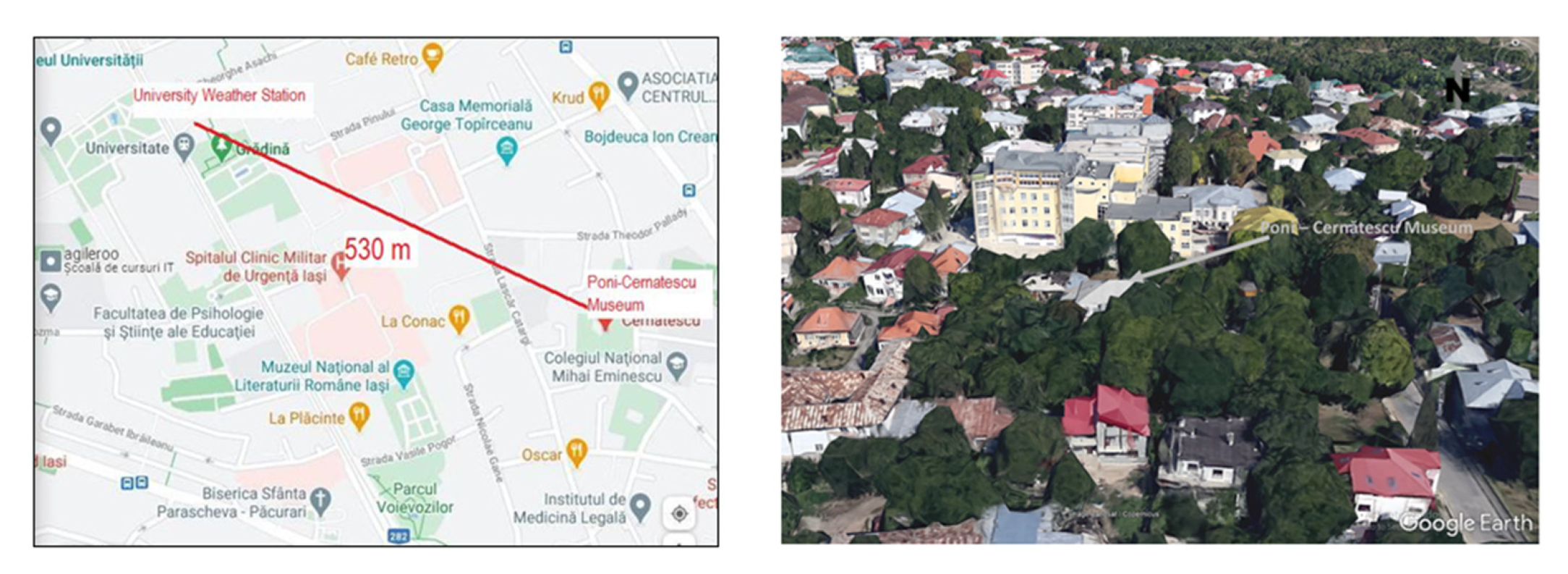
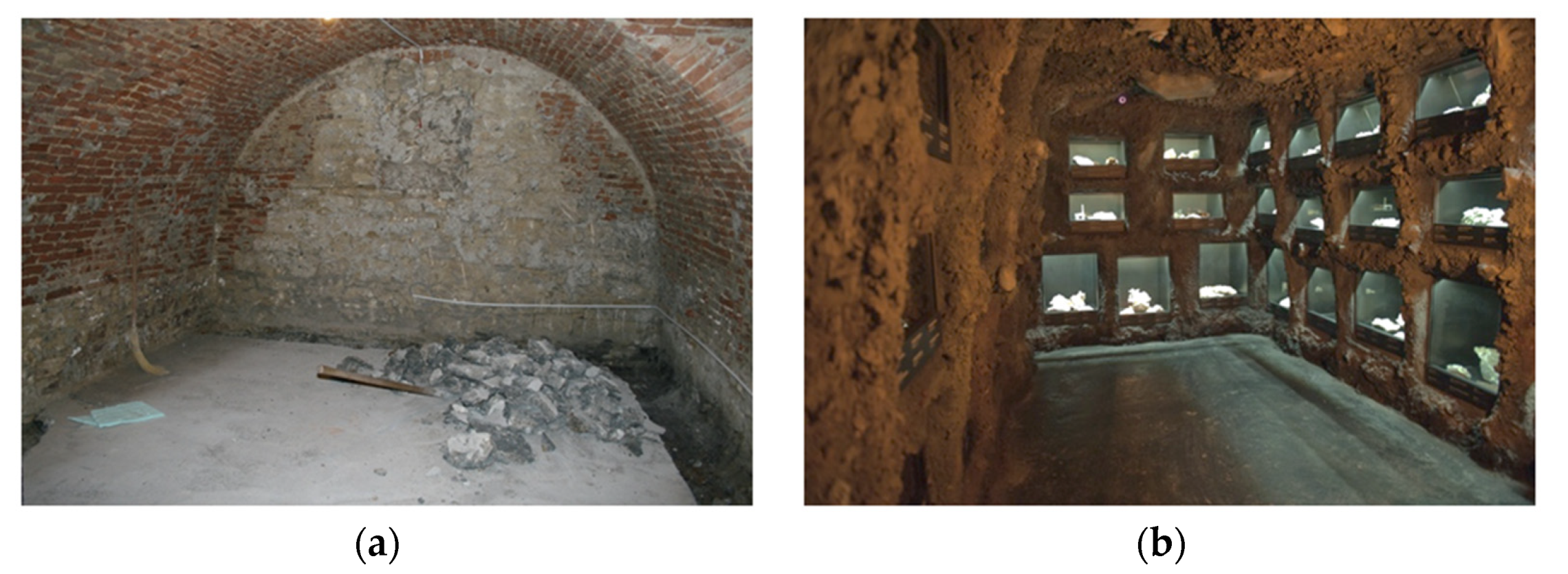




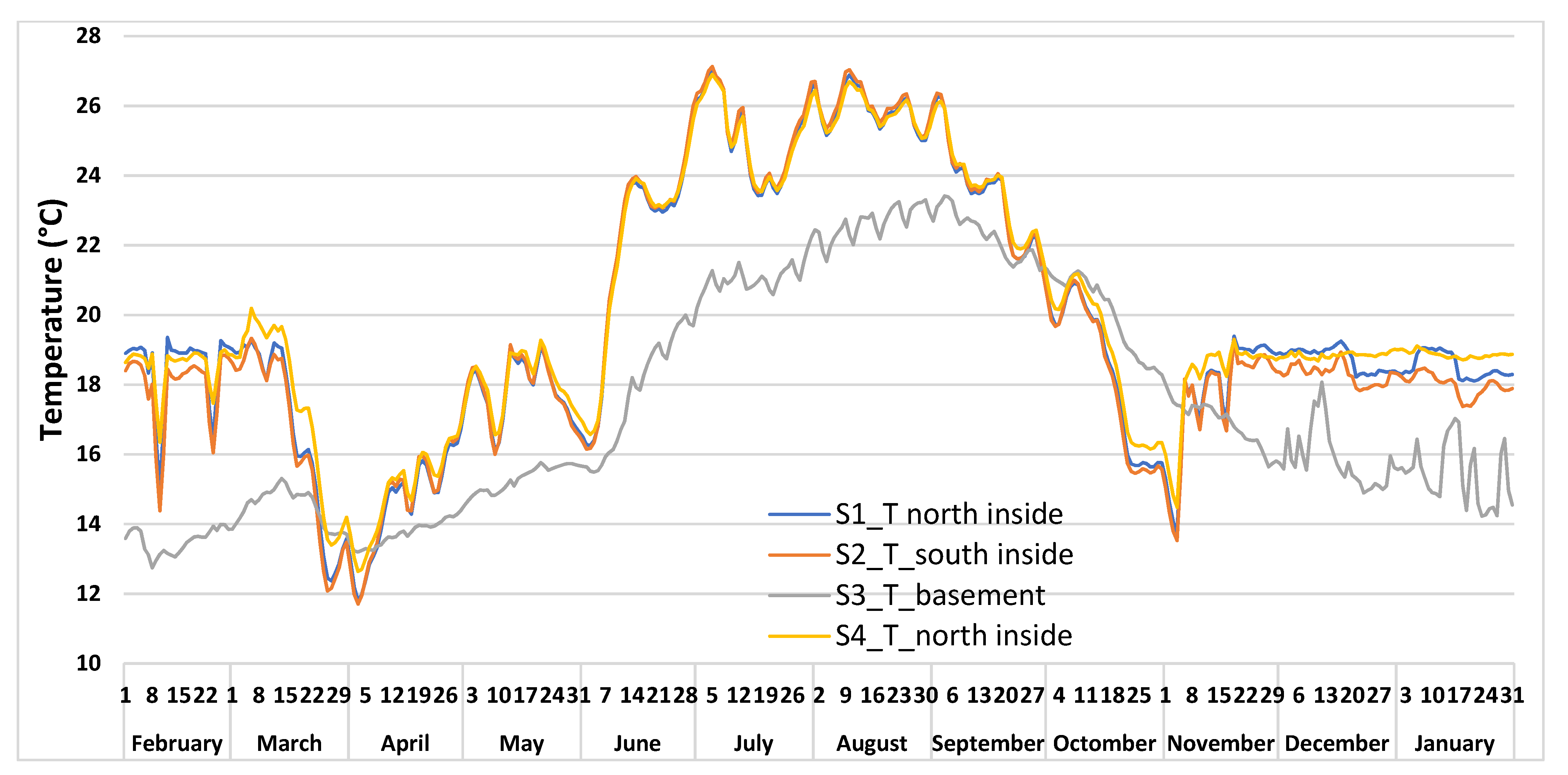
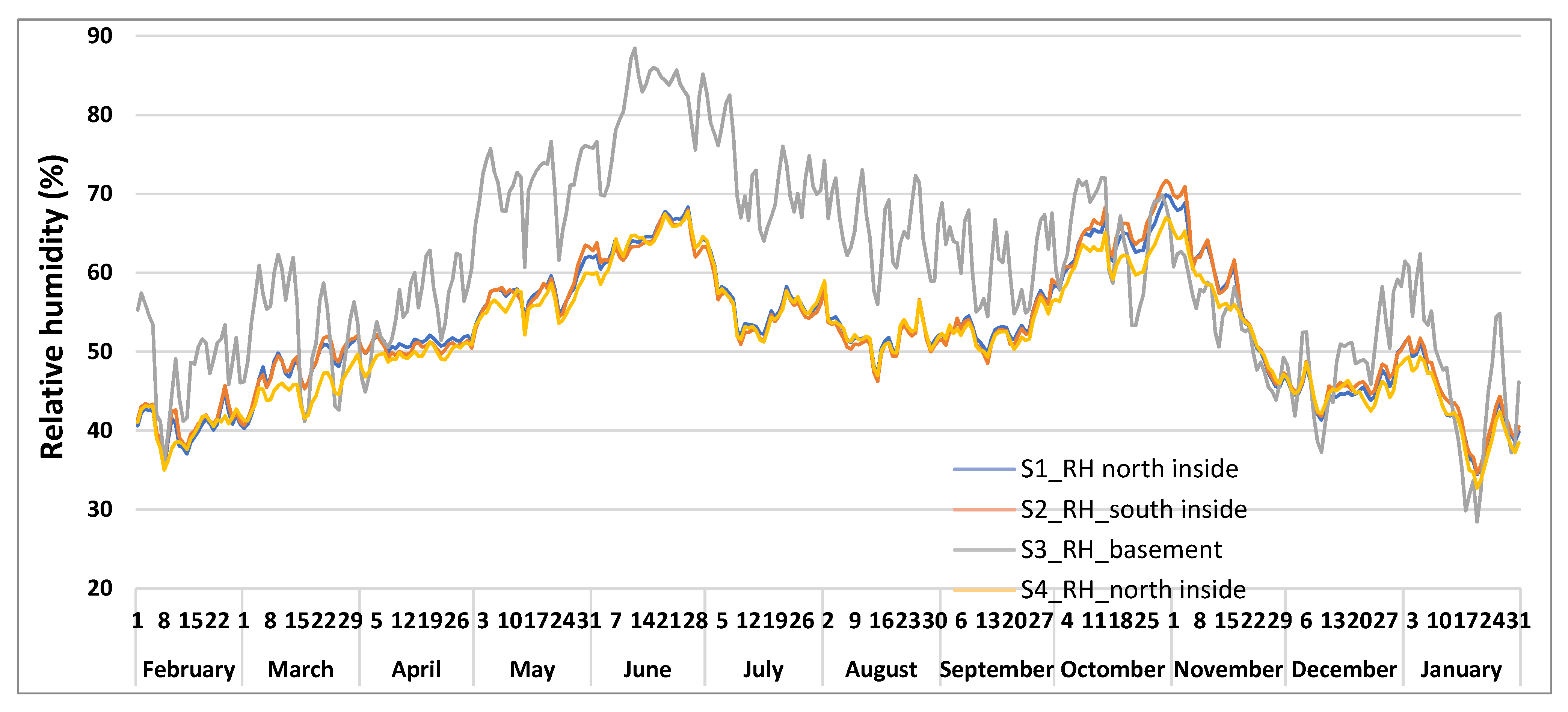
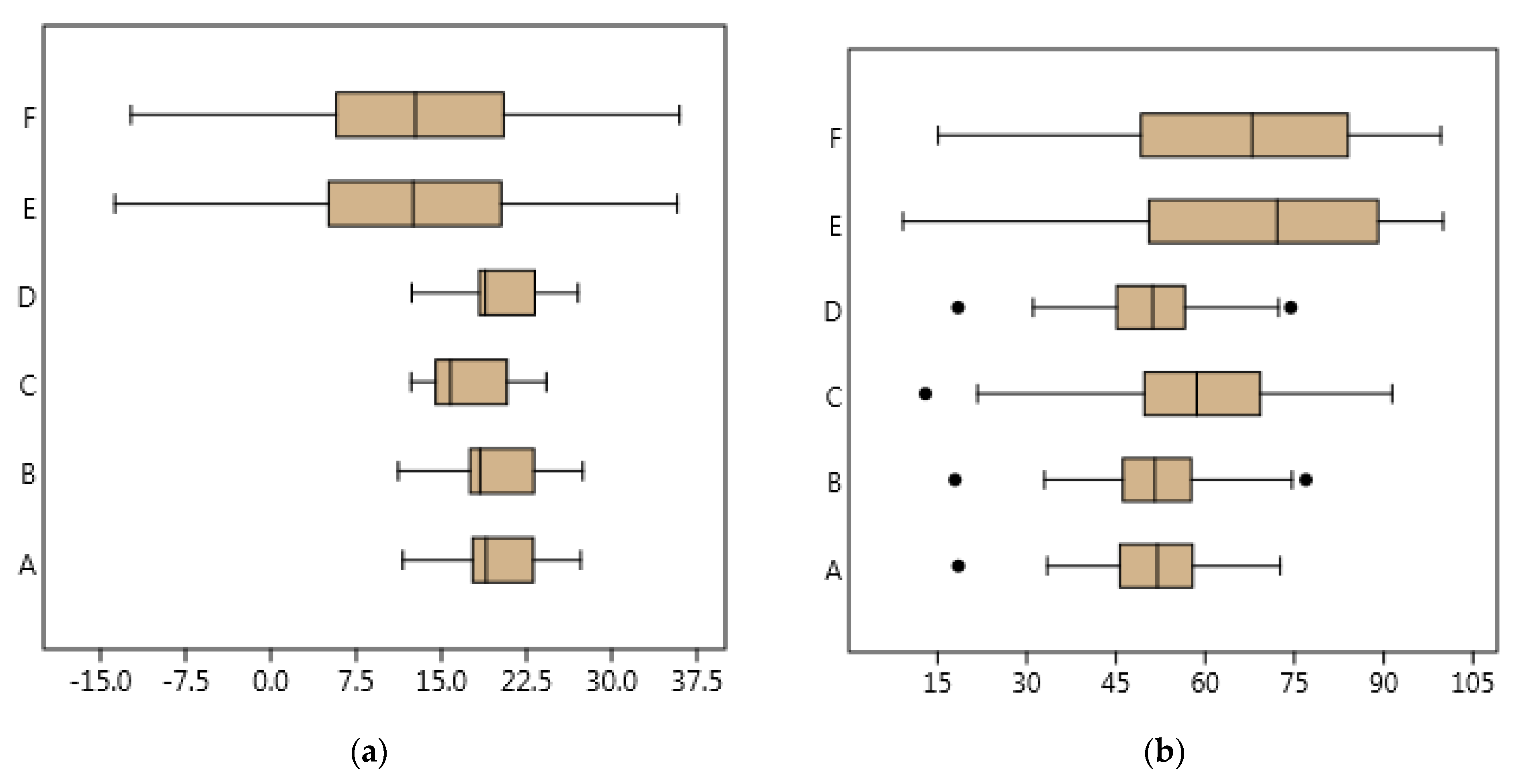
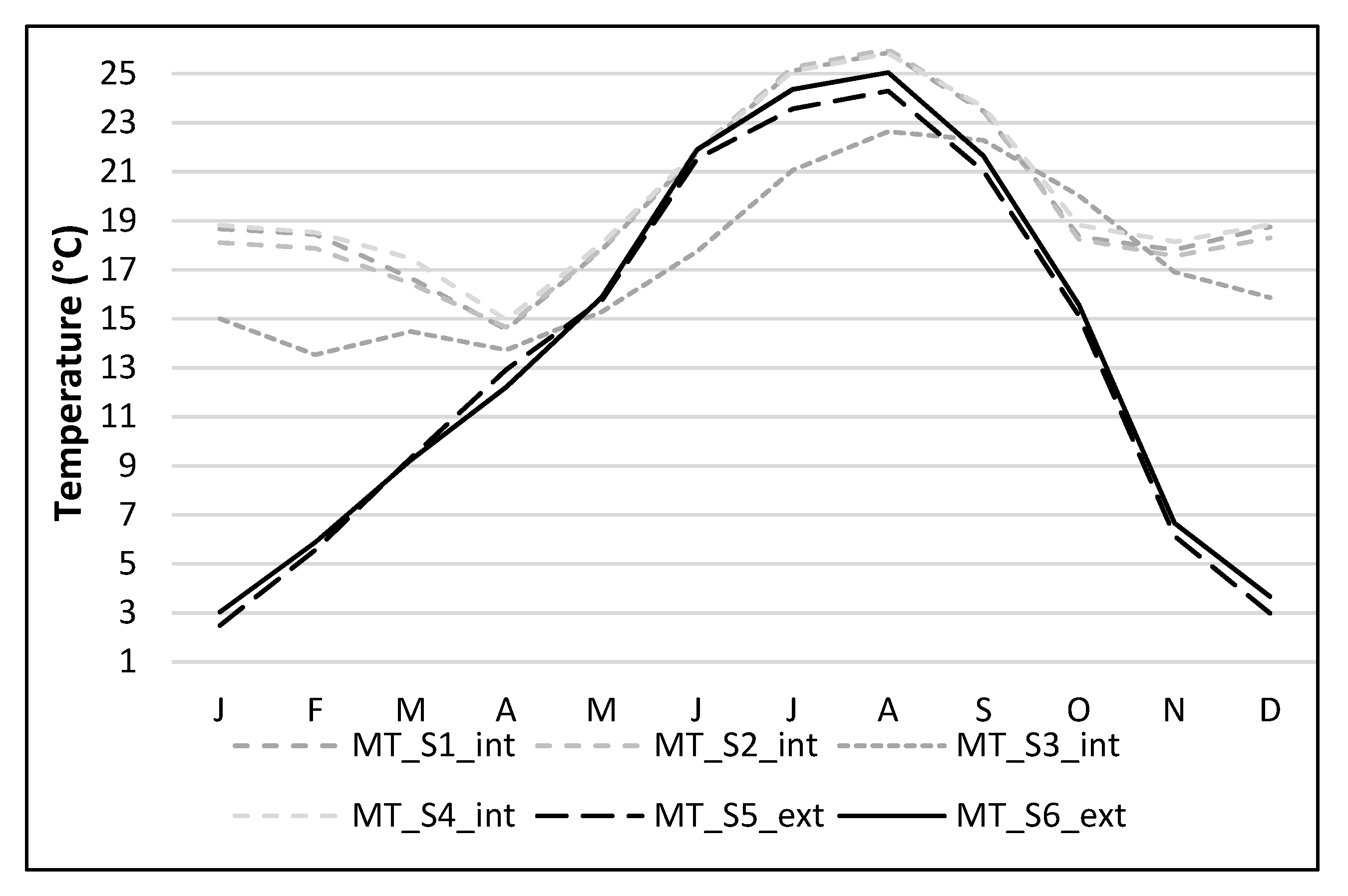
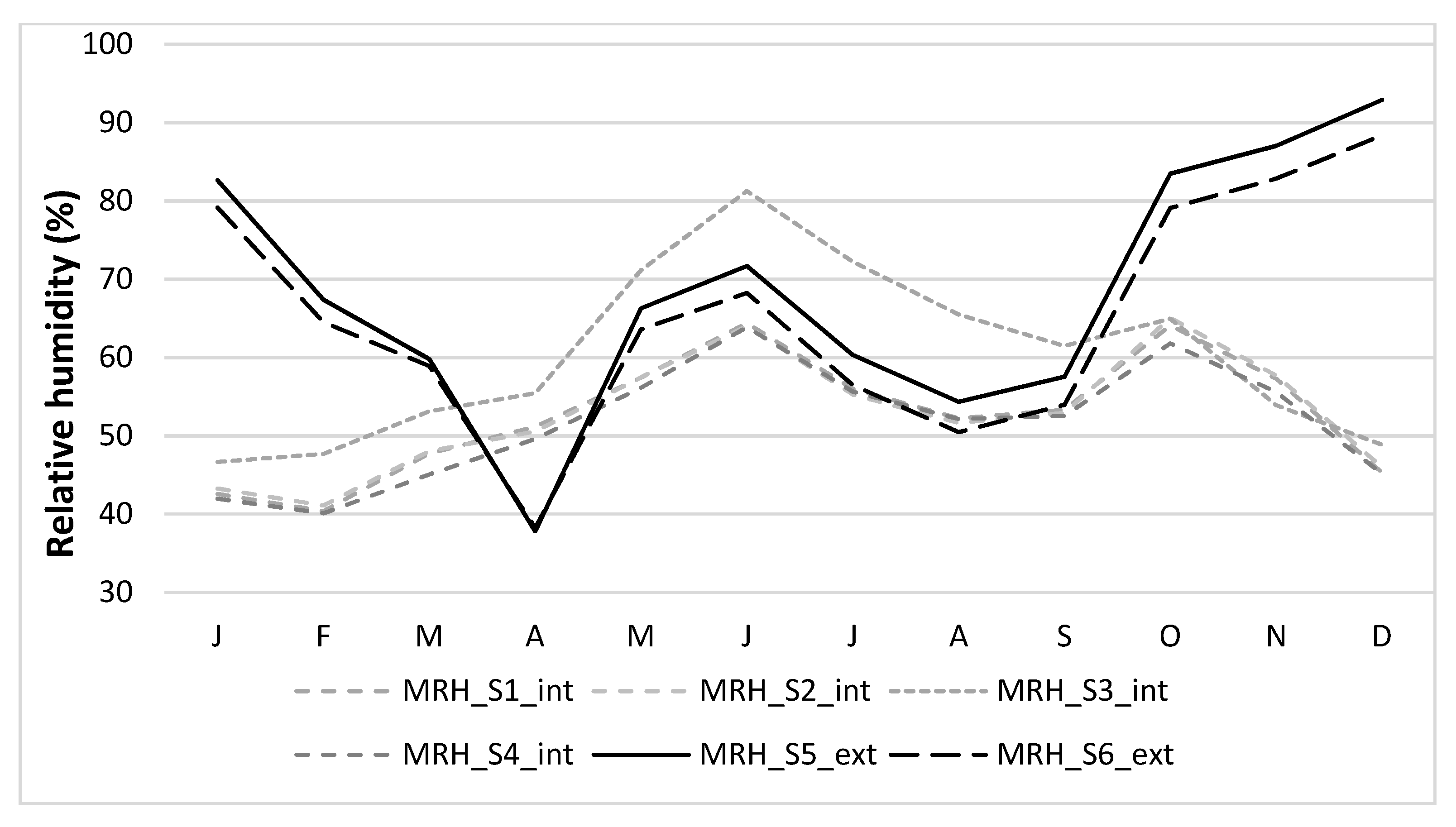

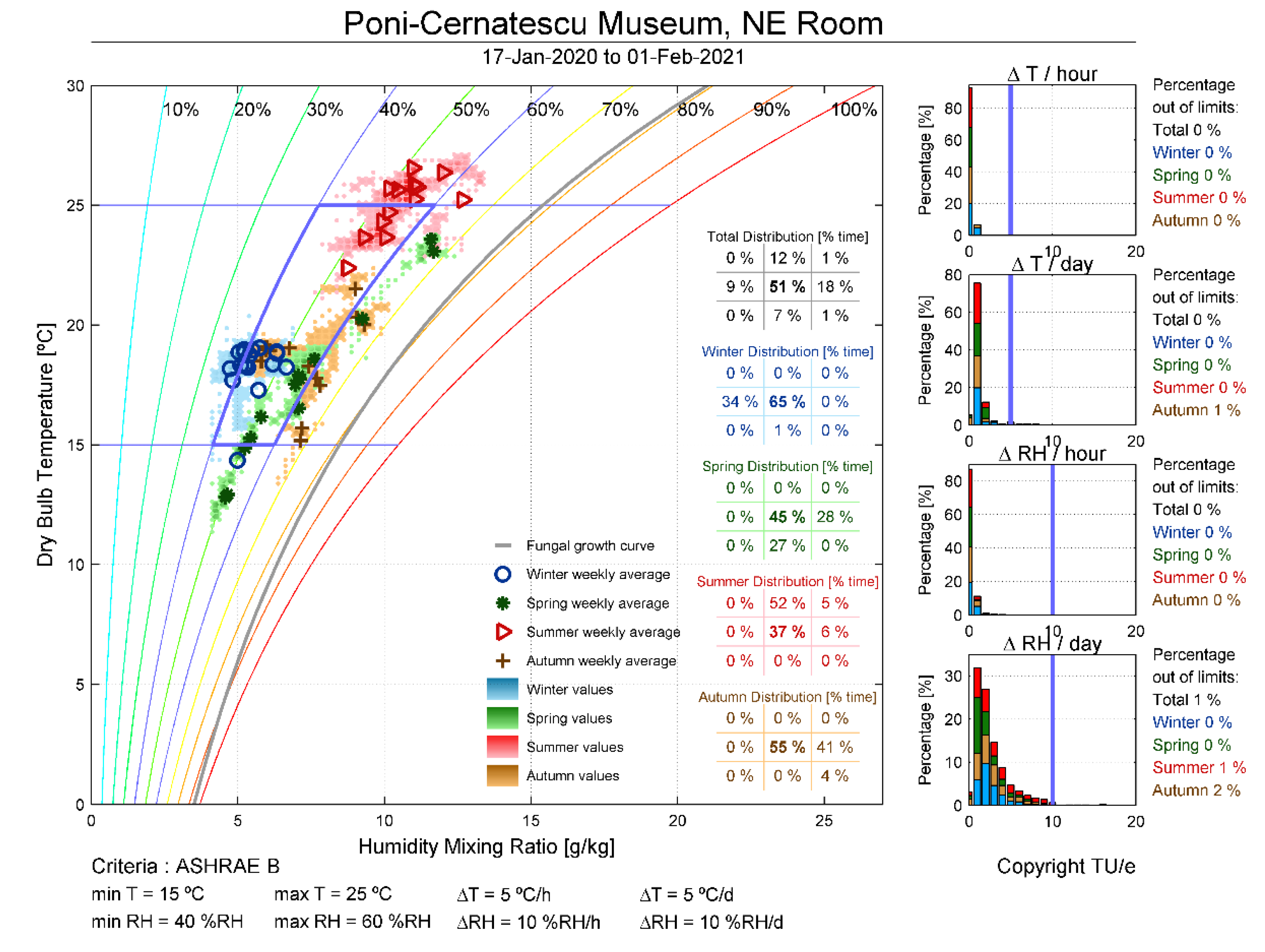
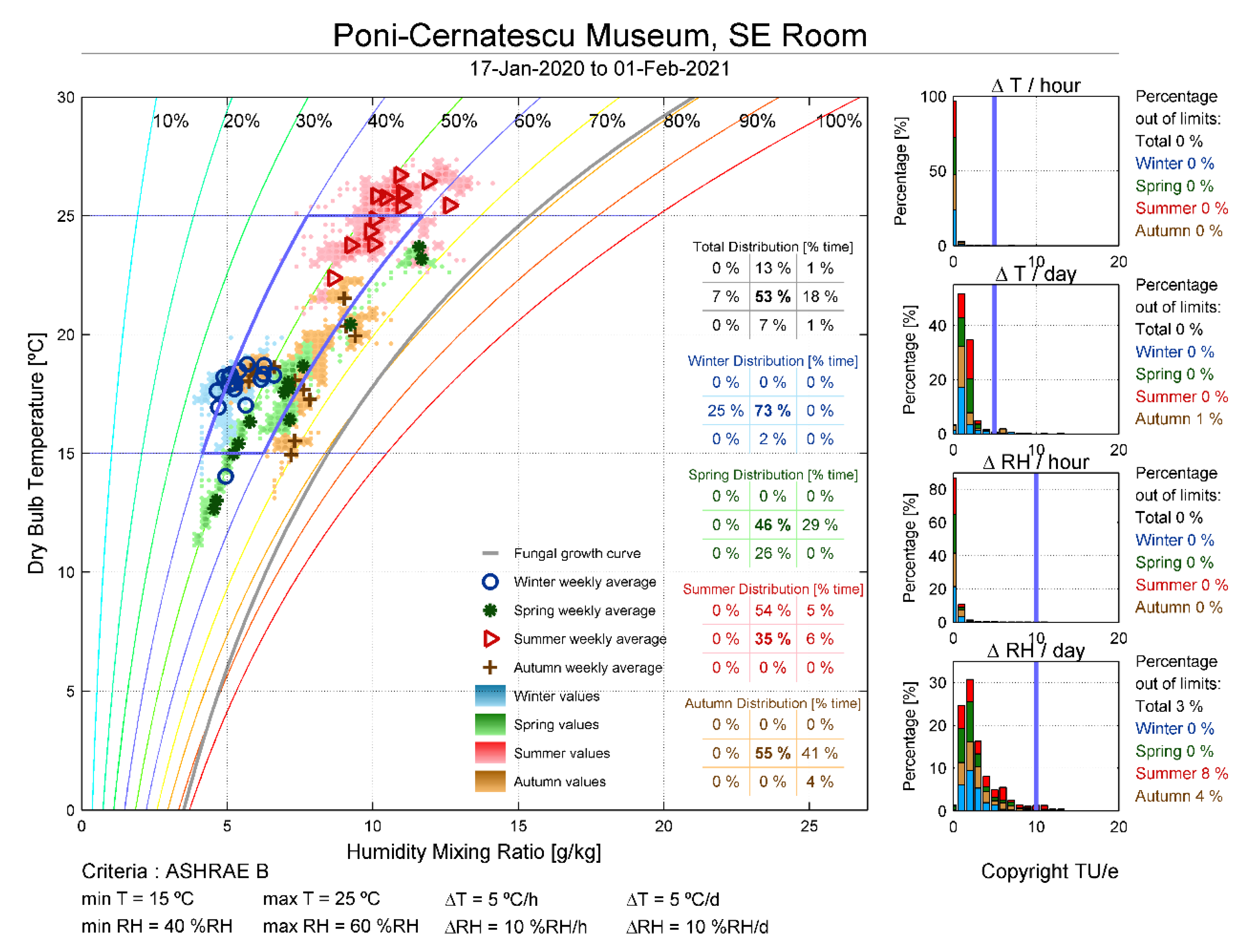

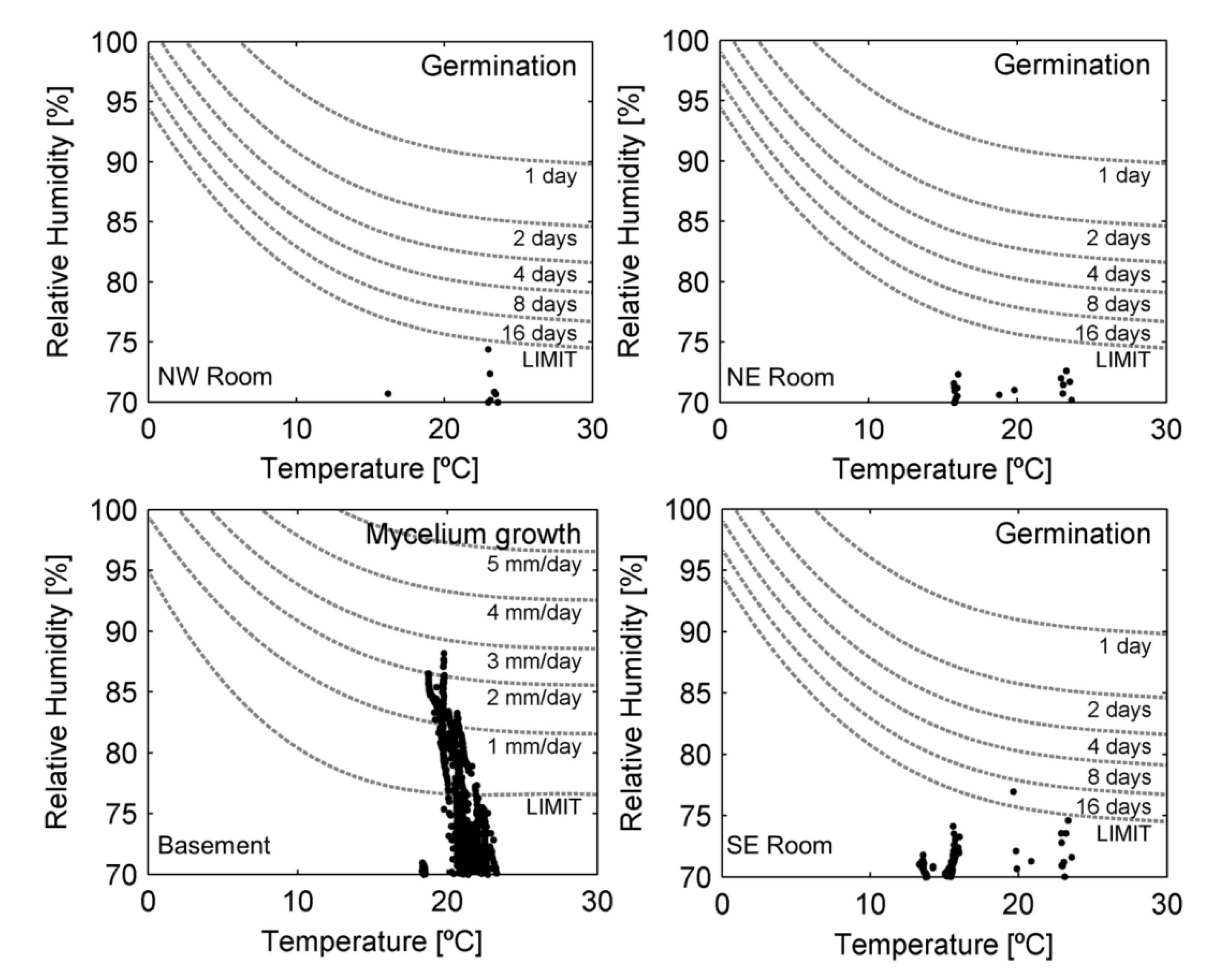
| Author | Objective | Region Climate | Period of Time | Methodology | HVAC System | Artifacts |
|---|---|---|---|---|---|---|
| Bienvenido-Huertas et al., 2021 [24] | Artificial intelligence to predict environmental performance in future scenarios | warm | 2015–2019; 2030–2100 | UNI 10829 Performance Index | No | Wooden objects, paintings |
| Ilieș, D.C. et al., 2022 [31] | Fungal growth | temperate | October 2020–March 2021 | ASHRAE Standard API® 20 C AUX identification system | No | Textile |
| De Rubeis, T. et al., 2020 [32] | Sensitivity of heating performance of energy self-sufficient building | warm | September 2019–November 2020 | EnergyPlus simulation model. | yes | N/A |
| Ishikawa, K. et al., 2021 [33] | Hygrothermal analysis | high humidity | Since February 2018 | Numerical model to simulate humidity and temperature changes in diffrent cases | no | Metal artifacts |
| Kompatscher, K. et al., 2019 [34] | Computational model on energy impact during the year | temperate, humidity | August 2016–August 2017 | ASHRAE HAMBASE Lifetime Multiplier | yes | Paper |
| ElAdl et al., 2021 [35] | Climate change | hot and dry | N/A | questionnaire | yes | Textiles, stone, fossils |
| Nawalany, G. et al., 2021 [16] | The analysis of the effects of the frequency of religious services and the number of people at the services on the formation of temperature and humidity conditions | temperate | May 2018–May 2019 | Numerical method of calculating elementary balances | no | wood |
| Palomar, T. et al., 2021 [19] | Assessing the environmental conditions | warm | March 2019–October 2020 | VOC analysis | no | glass |
| Efthymiou, C. et al., 2021 [36] | Indoor environmental quality | warm | February 2019–April 2021 | VOC analysis | no | manuscripts, scientific instruments, portrait paintings |
| Cooling Capacity (kW) | Heating Capacity (kW) | Heat Exchanger Water Volume (l) | Power Input (W) | Water Flow | Water Pressure Drop | Fan (m3/h) | Power Supply (Hz/V) | ||
|---|---|---|---|---|---|---|---|---|---|
| Cooling (l/h) | Heating (l/h) | Cooling (kPa) | Heating (kPa) | ||||||
| 6.2 | 6.3 | 1.42 | 40 | 1.06 | 581 | 24 | 15 | 1250 | 1~/50/220–240 |
| 2020 | 2021 | Mean | |||||||||||
|---|---|---|---|---|---|---|---|---|---|---|---|---|---|
| F | M | A | M | J | J | A | S | O | N | D | J | ||
| University WS | 5.1 | 8.1 | 11.6 | 14.7 | 21.5 | 23.1 | 23.8 | 19.8 | 14.3 | 5.0 | 2.7 | 0.7 | 12.5 |
| University WS–S5 | −0.8 | −1.2 | −1.3 | −1.1 | 0.0 | −0.5 | −0.5 | −1.2 | −0.8 | −1.1 | −0.3 | −1.0 | −0.8 |
| University WS–S6 | −1.1 | −1.2 | −0.6 | −1.2 | −0.4 | −1.2 | −1.2 | −1.8 | −1.2 | −1.6 | −1.0 | −1.7 | −1.2 |
| S5 (south outside) | 6.0 | 9.3 | 12.9 | 15.8 | 21.5 | 23.6 | 24.3 | 21.0 | 15.1 | 6.1 | 3.0 | 1.7 | 13.4 |
| S6 (north outside) | 6.3 | 9.2 | 12.2 | 15.9 | 21.9 | 24.4 | 25.1 | 21.6 | 15.6 | 6.7 | 3.7 | 2.3 | 13.7 |
| S5–S6 | −0.3 | 0.1 | 0.7 | −0.1 | −0.4 | −0.8 | −0.8 | −0.6 | −0.5 | −0.5 | −0.7 | −0.6 | −04 |
| 2020 | 2021 | Mean | |||||||||||
|---|---|---|---|---|---|---|---|---|---|---|---|---|---|
| F | M | A | M | J | J | A | S | O | N | D | J | ||
| University WS | 69.7 | 63.2 | 44.8 | 67.9 | 70.2 | 63.0 | 57.0 | 62.0 | 80.4 | 83.0 | 86.5 | 81.2 | 69.1 |
| University WS–S5 | 2.9 | 3.3 | 7.0 | 1.6 | −1.4 | 2.6 | 2.7 | 4.4 | −3.1 | −4.0 | −6.4 | −4.8 | 0.4 |
| University WS–S6 | 5.6 | 4.2 | 6.6 | 4.3 | 2.0 | 6.5 | 6.5 | 8.0 | 1.2 | 0.2 | −1.9 | −1.1 | 3.5 |
| S5 (south outside) | 66.8 | 59.8 | 37.8 | 66.3 | 71.7 | 60.3 | 54.3 | 57.6 | 83.5 | 87.0 | 92.9 | 86.1 | 68.7 |
| S6 (north outside) | 64.1 | 58.9 | 38.3 | 63.6 | 68.3 | 56.5 | 50.5 | 54.0 | 79.1 | 82.8 | 88.4 | 82.3 | 65.6 |
| S5–S6 | 2.7 | 0.9 | −0.5 | 2.7 | 3.4 | 3.8 | 3.9 | 3.6 | 4.4 | 4.2 | 4.5 | 3.7 | 3.1 |
| 2020 | 2021 | Mean | |||||||||||
|---|---|---|---|---|---|---|---|---|---|---|---|---|---|
| F | M | A | M | J | J | A | S | O | N | D | J | ||
| S1 north indoor | 18.5 | 16.7 | 14.6 | 17.8 | 21.8 | 25.1 | 25.9 | 23.5 | 18.4 | 17.8 | 18.8 | 18.5 | 19.8 |
| S4 north indoor | 18.5 | 17.5 | 15.0 | 18.1 | 21.8 | 25.1 | 25.8 | 23.6 | 18.8 | 18.2 | 18.8 | 18.9 | 20.0 |
| S2 south indoor | 17.9 | 16.4 | 14.7 | 17.9 | 21.9 | 25.3 | 26.0 | 23.5 | 18.2 | 17.6 | 18.3 | 18.0 | 19.6 |
| S3 basement | 13.5 | 14.5 | 13.7 | 15.3 | 17.8 | 21.1 | 22.6 | 22.3 | 20.0 | 16.9 | 15.9 | 15.4 | 17.4 |
| Mean north rooms | 18.5 | 17.1 | 14.8 | 18.0 | 21.8 | 25.1 | 25.8 | 23.6 | 18.6 | 18.0 | 18.8 | 18.7 | 19.9 |
| Mean indoor | 18.3 | 16.9 | 14.7 | 17.9 | 21.8 | 25.2 | 25.9 | 23.5 | 18.5 | 17.8 | 18.6 | 18.5 | 19.8 |
| Diff north–south | 0.6 | 0.6 | 0.1 | 0.1 | −0.1 | −0.1 | −0.2 | 0.0 | 0.3 | 0.4 | 0.5 | 0.7 | 0.3 |
| Diff indoor–basement | 4.8 | 2.4 | 1.0 | 2.6 | 4.1 | 4.1 | 3,.3 | 1.3 | −1.6 | 0.9 | 2.8 | 3.0 | 2.4 |
| 2020 | 2021 | Mean | |||||||||||
|---|---|---|---|---|---|---|---|---|---|---|---|---|---|
| F | M | A | M | J | J | A | S | O | N | D | J | ||
| S1 north indoor | 40.5 | 47.8 | 51.2 | 57.5 | 64.4 | 56.0 | 52.2 | 53.3 | 64.1 | 57.3 | 45.3 | 42.7 | 52.7 |
| S4 north indoor | 40.3 | 45.1 | 49.6 | 56.2 | 63.9 | 55.7 | 52.1 | 52.5 | 61.8 | 55.6 | 45.1 | 41.6 | 51.6 |
| S2 south indoor | 41.2 | 48.0 | 50.6 | 57.5 | 64.0 | 55.3 | 51.6 | 52.9 | 65.1 | 57.7 | 46.0 | 43.4 | 52.8 |
| S3 basement | 48.3 | 53.1 | 55.4 | 71.2 | 81.3 | 72.2 | 65.5 | 61.5 | 65.0 | 53.9 | 48.9 | 45.9 | 60.2 |
| Mean north rooms | 40.4 | 46.4 | 50.4 | 56.8 | 64.1 | 55.8 | 52.2 | 52.9 | 63.0 | 56.5 | 45.2 | 42.2 | 52.2 |
| Mean indoor | 40.7 | 47.0 | 50.4 | 57.0 | 64.1 | 55.6 | 52.0 | 52.9 | 63.7 | 56.9 | 45.5 | 42.6 | 52.4 |
| Diff north–south | −0.8 | −1.6 | −0.2 | −0.7 | 0.1 | 0.5 | 0.5 | 0.0 | −2.1 | −1.2 | −0.8 | −1.2 | −0.6 |
| Diff indoor–basement | −7.6 | −6.2 | −5.0 | −14.1 | −17.2 | −16.6 | −13.5 | −8.6 | −1.3 | 2.9 | −3.4 | −3.3 | −7.8 |
| Temperature | Humidity | |||||||||||
|---|---|---|---|---|---|---|---|---|---|---|---|---|
| Unheated period | A | B | C | D | E | F | A | B | C | D | E | F |
| Median | 20.17 | 20.11 | 18.78 | 20.55 | 18.5 | 18.5 | 53.5 | 53.16 | 65.7 | 53.03 | 60.26 | 57.16 |
| Min | 11.6 | 11.2 | 13.08 | 12.38 | −3.7 | −1.9 | 37.72 | 38.67 | 37.17 | 37.3 | 9.1 | 15.09 |
| Max | 27.25 | 27.5 | 24.4 | 227.03 | 35.74 | 35.9 | 72.6 | 76.9 | 91.42 | 74.37 | 100 | 96.62 |
| 25% | 17.34 | 17.2 | 14.76 | 17.27 | 12.46 | 12.77 | 51.02 | 50.5 | 56.7 | 49.57 | 42.55 | 41.9 |
| 75% | 24.24 | 24.3 | 21.5 | 24.38 | 22.94 | 23.13 | 48.12 | 48.59 | 55.22 | 47.21 | 93.60 | 88.75 |
| Heated period | ||||||||||||
| Median | 18.69 | 18.15 | 15.58 | 18.77 | 4.14 | 4.76 | 44.87 | 45.77 | 49.32 | 45.16 | 88.05 | 83.48 |
| Min | 13.5 | 13.3 | 12.37 | 12.34 | −3.74 | −1.958 | 18.4 | 17.9 | 12.3 | 18.43 | 19 | 24.36 |
| Max | 21.7 | 20.3 | 20.69 | 21.29 | 21.41 | 20.17 | 72.3 | 74.11 | 70.97 | 70.71 | 100 | 99.6 |
| 25% | 18.15 | 17.7 | 14.2 | 18.58 | 1.39 | 2.28 | 40.03 | 40.7 | 44.42 | 39.8 | 75.53 | 71.28 |
| 75% | 18.98 | 18.4 | 17.2 | 18.88 | 7.87 | 8.1 | 53.58 | 53.6 | 56.53 | 53.61 | 94.6 | 89.9 |
| Correlation R | S1 | S2 | S3 | S4 | S5 |
|---|---|---|---|---|---|
| S1 | 0.99 | 0.89 | 0.99 | 0.93 | |
| S2 | 0.88 | 0.99 | 0.94 | ||
| S3 | 0.89 | 0.83 | |||
| S4 | 0.91 | ||||
| S5 |
| Correlation R | S1 | S2 | S3 | S4 | S5 |
|---|---|---|---|---|---|
| S1 | 0.99 | 0.77 | 0.98 | 0.77 | |
| S2 | 0.72 | 0.97 | 0.81 | ||
| S3 | 0.83 | 0.51 | |||
| S4 | 0.72 | ||||
| S5 |
| Statistical Data | Temperature | Relative Humidity | ||||||||
|---|---|---|---|---|---|---|---|---|---|---|
| Mean | Drop | Rise | Tmin | Tmax | Mean | Drop | Rise | RHmin | RHmax | |
| NW room | 20.0 | 3.3 | 5.1 | 12.5 | 27.0 | 51.1 | 11.0 | 7.5 | 32.4 | 69.3 |
| NE room | 19.7 | 3.6 | 5.3 | 11.7 | 27.1 | 52.1 | 12.0 | 7.2 | 34.0 | 71.0 |
| SE room | 19.6 | 3.4 | 5.6 | 11.4 | 27.4 | 52.2 | 12.0 | 6.8 | 34.4 | 72.7 |
| Basement | 17.3 | 3.8 | 4.8 | 12.7 | 24.0 | 59.5 | 13.0 | 15.0 | 24.4 | 90.4 |
| ASHRAE Classification | AA (%) | As (%) | A (%) | B (%) | C (%) | D (%) | ||||
| NW room | 37.4 | 65.7 | 61.1 | 98.6 | 100.0 | 100.0 | ||||
| NE room | 35.1 | 60.7 | 56.2 | 97.7 | 100.0 | 100.0 | ||||
| SE room | 35.5 | 58.7 | 56.3 | 97.0 | 100.0 | 100.0 | ||||
| Basement | 27.2 | 49.9 | 51.4 | 80.1 | 89.3 | 89.3 | ||||
| Mould Growth Rate | ||||
|---|---|---|---|---|
| NW Room | NE Room | SE Room | Basement | |
| Paper | safe | safe | safe | 8 mm |
| Panel painting | safe | safe | safe | 8 mm |
| Furniture | safe | safe | safe | 8 mm |
| Sculpture | safe | safe | safe | 8 mm |
| Temperature | Relative Humidity | |||
|---|---|---|---|---|
| Set point | Fluctuations | Set point | Fluctuations | |
| Paper | chemical major risk | - low risk | chemical high risk | mechanical medium risk |
| Canvas painting | chemical medium risk | - low risk | chemical medium risk | mechanical high risk |
| Textiles | chemical medium risk | - low risk | chemical medium risk | mechanical medium risk |
| Wooden furniture | chemical medium risk | - low risk | chemical medium risk | mechanical high risk |
| Bronze sculpture | - low risk | - low risk | chemical medium risk | - low risk |
| LM (Lifetime Multiplier) | Base Material | Pictorial Layer | ||||||||||
|---|---|---|---|---|---|---|---|---|---|---|---|---|
| NW Room | NE Room | SE Room | Basement | NW Room | NE Room | SE Room | Basement | NW Room | NE Room | SE Room | Basement | |
| Paper | 0.843 | 0.845 | 0.852 | 0.988 | - | - | - | - | - | - | - | - |
| Panel painting | 0.9 | 0.898 | 0.905 | 0.943 | safe | safe | safe | damage possible | safe | safe | safe | damage possible |
| Furniture | 0.896 | 0.893 | 0.9 | 0.936 | safe | safe | safe | damage possible | - | - | - | - |
| Sculpture | 0.901 | 0.899 | 0.905 | 0.945 | safe | safe | safe | damage possible | - | - | - | - |
| T (°C) | RH (%) | DP (°C) | PI | Days to Mold | EMC (%) | T (°C) | RH (%) | DP (°C) | PI | Days to Mold | EMC (%) | |
|---|---|---|---|---|---|---|---|---|---|---|---|---|
| NW Room | Basement | |||||||||||
| F | 19 | 41 | 5 | 63 | no risk | 7.9 | 14 | 48 | 3 | 99 | no risk | 9.1 |
| M | 17 | 48 | 6 | 67 | no risk | 9 | 15 | 53 | 5 | 76 | no risk | 9.9 |
| A | 15 | 51 | 5 | 80 | no risk | 9.50 | 14 | 55 | 5 | 81 | no risk | 10.2 |
| M | 17 | 58 | 8 | 51 | no risk | 10.70 | 15 | 71 | 9 | 46 | no risk | 13.5 |
| J | 22 | 64 | 15 | 24 | no risk | 11.70 | 18 | 81 | 15 | 25 | 12 | 16.5 |
| J | 25 | 56 | 16 | 21 | no risk | 10.10 | 21 | 72 | 16 | 22 | 86 | 13.6 |
| A | 26 | 52 | 15 | 20 | no risk | 9.40 | 23 | 66 | 16 | 20 | no risk | 12.1 |
| S | 24 | 53 | 13 | 25 | no risk | 9.60 | 22 | 62 | 14 | 25 | no risk | 11.3 |
| O | 18 | 64 | 11 | 39 | no risk | 11.90 | 20 | 65 | 13 | 29 | no risk | 12 |
| N | 18 | 57 | 9 | 47 | no risk | 10.50 | 17 | 54 | 8 | 57 | no risk | 10 |
| D | 19 | 45 | 7 | 57 | no risk | 8.50 | 15 | 49 | 5 | 85 | no risk | 9.2 |
| J | 19 | 52 | 9 | 47 | no risk | 9.60 | 15 | 46 | 4 | 92 | no risk | 8.7 |
Publisher’s Note: MDPI stays neutral with regard to jurisdictional claims in published maps and institutional affiliations. |
© 2022 by the authors. Licensee MDPI, Basel, Switzerland. This article is an open access article distributed under the terms and conditions of the Creative Commons Attribution (CC BY) license (https://creativecommons.org/licenses/by/4.0/).
Share and Cite
Florescu, O.; Ichim, P.; Sfîcă, L.; Kadhim-Abid, A.-L.; Sandu, I.; Nănescu, M. Risk Assessment of Artifact Degradation in a Museum, Based on Indoor Climate Monitoring—Case Study of “Poni-Cernătescu” Museum from Iași City. Appl. Sci. 2022, 12, 3313. https://doi.org/10.3390/app12073313
Florescu O, Ichim P, Sfîcă L, Kadhim-Abid A-L, Sandu I, Nănescu M. Risk Assessment of Artifact Degradation in a Museum, Based on Indoor Climate Monitoring—Case Study of “Poni-Cernătescu” Museum from Iași City. Applied Sciences. 2022; 12(7):3313. https://doi.org/10.3390/app12073313
Chicago/Turabian StyleFlorescu, Oana, Pavel Ichim, Lucian Sfîcă, Adriana-Lucia Kadhim-Abid, Ion Sandu, and Monica Nănescu. 2022. "Risk Assessment of Artifact Degradation in a Museum, Based on Indoor Climate Monitoring—Case Study of “Poni-Cernătescu” Museum from Iași City" Applied Sciences 12, no. 7: 3313. https://doi.org/10.3390/app12073313
APA StyleFlorescu, O., Ichim, P., Sfîcă, L., Kadhim-Abid, A.-L., Sandu, I., & Nănescu, M. (2022). Risk Assessment of Artifact Degradation in a Museum, Based on Indoor Climate Monitoring—Case Study of “Poni-Cernătescu” Museum from Iași City. Applied Sciences, 12(7), 3313. https://doi.org/10.3390/app12073313







